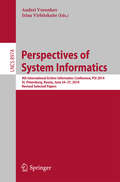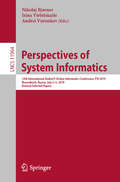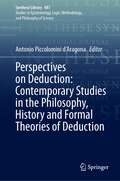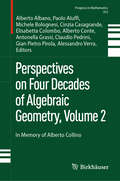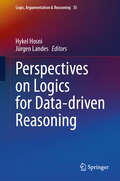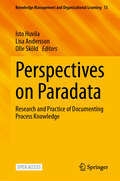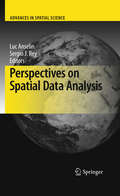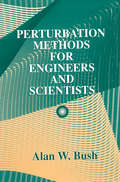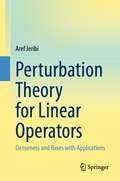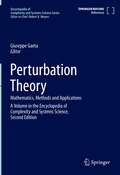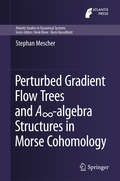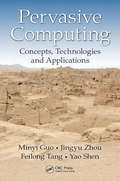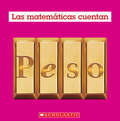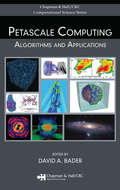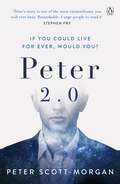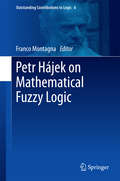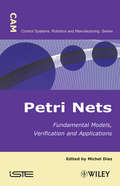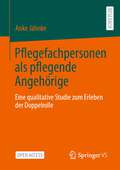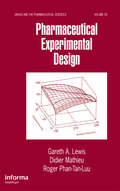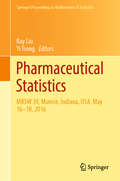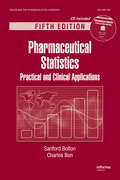- Table View
- List View
Perspectives of System Informatics
by Andrei Voronkov Irina VirbitskaiteThis book contains the thoroughly refereed papers from the 9th International Ershov Informatics Conference, PSI 2014, held in St. Petersburg, Russia, in June 2014. The 17 revised full papers, 11 revised short papers, and 2 system and experimental papers presented in this book were carefully reviewed and selected from 80 submissions. The volume also contains 5 keynote talks which cover a range of hot topics in computer science and informatics. The papers cover various topics related to the foundations of program and system development and analysis, programming methodology and software engineering and information technologies.
Perspectives of System Informatics: 12th International Andrei P. Ershov Informatics Conference, PSI 2019, Novosibirsk, Russia, July 2–5, 2019, Revised Selected Papers (Lecture Notes in Computer Science #11964)
by Nikolaj Bjørner Andrei Voronkov Irina VirbitskaiteThis book constitutes the refereed proceedings of the 12th International Andrei P. Ershov Informatics Conference, PSI 2019, held in Novosibirsk, Russia, in July 2019.The 18 full papers and 3 short papers presented in this volume were carefully reviewed and selected from 70 submissions. The papers cover various topics related to the Mathematics of Computing, Information Systems, Formal Languages, dependable and fault-tolerant Systems and Network, Automata Theory, and much more.
Perspectives on Deduction: Contemporary Studies in the Philosophy, History and Formal Theories of Deduction (Synthese Library #481)
by Antonio Piccolomini D'AragonaThis book provides philosophers and logicians with a broad spectrum of views on contemporary research on the problem of deduction, its justification and explanation. The variety of distinct approaches exemplified by the single chapters allows for a dialogue between perspectives that, usually, barely communicate with each other.The contributions concern (in a possibly intertwined way) three major perspectives in logic: philosophical, historical, formal. The philosophical perspective has to do with the relationship between deductive validity and truth, and questions the alleged conclusiveness of deduction and its epistemic contribution. It also discusses the role of linguistic acts in deductive practice, and provides a cognitive-didactic contribution on how we may learn through deduction. In the historical perspective, the contributions discuss the ideas of some major historical figures, such as Bolzano, Girard, Gödel, and Peano. Finally, in the formal perspective, the mathematics of deduction is dealt with mainly from an intuitionistic-constructivist or proof-theoretic point of view, with focus on “ecumenic” or internalistic approaches to logical validity, on the nature and identity of proofs, and on dialogical setups.Chapter [14] is available open access under a Creative Commons Attribution 4.0 International License via link.springer.com.
Perspectives on Four Decades of Algebraic Geometry, Volume 1: In Memory of Alberto Collino (Progress in Mathematics #351)
by Gian Pietro Pirola Alberto Conte Alessandro Verra Antonella Grassi Elisabetta Colombo Alberto Albano Paolo Aluffi Michele Bolognesi Cinzia Casagrande Claudio PedriniThe first of a two-part volume, this collection offers a unifying vision of algebraic geometry, exploring its evolution over the last four decades as well as state-of-the art research. With chapters written by established leaders in the field as well as younger researchers, readers will gain a wide-ranging perspective of the area. The volume also commemorates the significant talent and contributions of Alberto Collino, whose scientific accomplishments helped shape the themes and topics covered. Perspectives on Four Decades of Algebraic Geometry, Volume 1 will be a valuable resource for those interested in the ways algebraic geometry has expanded over the years and continues to grow. "Quadratic Counts of Twisted Cubics" is available open access under a Creative Commons Attribution 4.0 International License via link.springer.com.
Perspectives on Four Decades of Algebraic Geometry, Volume 2: In Memory of Alberto Collino (Progress in Mathematics #352)
by Gian Pietro Pirola Alberto Conte Alessandro Verra Antonella Grassi Elisabetta Colombo Alberto Albano Paolo Aluffi Michele Bolognesi Cinzia Casagrande Claudio PedriniThe second of a two-part volume, this collection offers a unifying vision of algebraic geometry, exploring its evolution over the last four decades as well as state-of-the art research. With chapters written by established leaders in the field as well as younger researchers, readers will gain a wide-ranging perspective of the area. The volume also commemorates the significant talent and contributions of Alberto Collino, whose scientific accomplishments helped shape the themes and topics covered. Perspectives on Four Decades of Algebraic Geometry, Volume 2 will be a valuable resource for those interested in the ways algebraic geometry has expanded over the years and continues to grow.
Perspectives on Logics for Data-driven Reasoning (Logic, Argumentation & Reasoning #35)
by Hykel Hosni Jürgen LandesThis book calls for a rethinking of logic as the core methodological tool for scientific reasoning in the context of a steadily increasing emphasis on data-centered science. To do so it provides a state-of-the-art presentation of the role logic can have in making the most of the current opportunities while making explicit the key challenges opened up by the data-driven age of scientific research. Particular attention is given to the following four core fields and applications: Reasoning with correlations (medical, life-science applications); logics for statistical inference (machine learning, and societal applications thereof); reasoning with evidence (defining good evidence); causal reasoning (forensic reasoning). The book collects contributions from key logicians, methodologists and scientists. This multidisciplinary perspective benefits both scientists and logicians interested in data-driven science. Scientists are introduced to logics that go beyond classical and thus are applicable to reasoning with data; Logicians have a change to focus on the potential applications of their methods and techniques to pressing scientific problems. This book is, therefore, of interest to scientists and logicians working on data-centered science.
Perspectives on Paradata: Research and Practice of Documenting Process Knowledge (Knowledge Management and Organizational Learning #13)
by Isto Huvila Lisa Andersson Olle SköldThis open access book examines a rapidly 'datafied' society, reminding us that it is crucial to know what data is about and where it originates. This insight has led to an embryonic stage of new theorizing, empirical research, and the formation of new technologies, standards, practices, and concepts to ensure the availability of adequate 'paradata' – data on the making and processing of data. This edited volume aims to provide a cross-disciplinary overview of perspectives on the concept and phenomenon of paradata and its implications for research and practice.
Perspectives on Spatial Data Analysis
by Luc Anselin Sergio J. ReyThis book takes both a retrospective and prospective view of the field of spatial analysis by combining selected reprints of classic articles by Arthur Getis with current observations by leading experts in the field. Four main aspects are highlighted, dealing with spatial analysis, pattern analysis, local statistics as well as illustrative empirical applications. Researchers and students will gain an appreciation of Getis' methodological contributions to spatial analysis and the broad impact of the methods he has helped pioneer on an impressively broad array of disciplines including spatial epidemiology, demography, economics, and ecology. The volume is a compilation of high impact original contributions, as evidenced by citations, and the latest thinking on the field by leading scholars. This makes the book ideal for advanced seminars and courses in spatial analysis as well as a key resource for researchers seeking a comprehensive overview of recent advances and future directions in the field.
Perspectives on Spin Glasses
by Pierluigi Contucci Cristian GiardinàPresenting and developing the theory of spin glasses as a prototype for complex systems, this book is a rigorous and up-to-date introduction to their properties. The book combines a mathematical description with a physical insight of spin glass models. Topics covered include the physical origins of those models and their treatment with replica theory; mathematical properties like correlation inequalities and their use in the thermodynamic limit theory; main exact solutions of the mean field models and their probabilistic structures; and the theory of the structural properties of the spin glass phase such as stochastic stability and the overlap identities. Finally, a detailed account is given of the recent numerical simulation results and properties, including overlap equivalence, ultrametricity and decay of correlations. The book is ideal for mathematical physicists and probabilists working in disordered systems.
Perturbation Methods
by E. J. HinchPerturbation methods are one of the fundamental tools used by all applied mathematicians and theoretical physicists. In this book, the author has managed to present the theory and techniques underlying such methods in a manner which will give the text wide appeal to students from a broad range of disciplines. Asymptotic expansions, strained coordinates and multiple scales are illustrated by copious use of examples drawn from all areas of applied mathematics and theoretical physics. The philosophy adopted is that there is no single or best method for such problems, but that one may exploit the small parameter given some experience and understanding of similar perturbation problems. The author does not look to perturbation methods to give quantitative answers but rather to give a physical understanding of the subtle balances in a complex problem.
Perturbation Methods for Engineers and Scientists
by AlanW. BushThe subject of perturbation expansions is a powerful analytical technique which can be applied to problems which are too complex to have an exact solution, for example, calculating the drag of an aircraft in flight. These techniques can be used in place of complicated numerical solutions. This book provides an account of the main techniques of perturbation expansions applied to both differential equations and integral expressions. Features include a non-rigorous treatment of the subject at undergraduate level not available in any other current text; contains computer programs to enable the student to explore particular ideas and realistic case studies of industrial applications; a number of practical examples are included in the text to enhance understanding of points raised, particularly in the areas of mechanics and fluid mechanics; presents the main techniques of perturbation expansion at a level accessible to the undergraduate student.
Perturbation Theory for Linear Operators: Denseness and Bases with Applications
by Aref JeribiThis book discusses the important aspects of spectral theory, in particular, the completeness of generalised eigenvectors, Riesz bases, semigroup theory, families of analytic operators, and Gribov operator acting in the Bargmann space. Recent mathematical developments of perturbed non-self-adjoint operators are discussed with the completeness of the space of generalized eigenvectors, bases on Hilbert and Banach spaces and asymptotic behavior of the eigenvalues of these operators. Most results in the book are motivated by physical problems, such as the perturbation method for sound radiation by a vibrating plate in a light fluid, Gribov operator in Bargmann space and other applications in mathematical physics and mechanics. This book is intended for students, researchers in the field of spectral theory of linear non self-adjoint operators, pure analysts and mathematicians.
Perturbation Theory: Mathematics, Methods and Applications (Encyclopedia of Complexity and Systems Science Series)
by Giuseppe GaetaThis volume in the Encyclopedia of Complexity and Systems Science, Second Edition, is devoted to the fundamentals of Perturbation Theory (PT) as well as key applications areas such as Classical and Quantum Mechanics, Celestial Mechanics, and Molecular Dynamics. Less traditional fields of application, such as Biological Evolution, are also discussed. Leading scientists in each area of the field provide a comprehensive picture of the landscape and the state of the art, with the specific goal of combining mathematical rigor, explicit computational methods, and relevance to concrete applications. New to this edition are chapters on Water Waves, Rogue Waves, Multiple Scales methods, legged locomotion, Condensed Matter among others, while all other contributions have been revised and updated. Coverage includes the theory of (Poincare’-Birkhoff) Normal Forms, aspects of PT in specific mathematical settings (Hamiltonian, KAM theory, Nekhoroshev theory, and symmetric systems), technical problems arising in PT with solutions, convergence of series expansions, diagrammatic methods, parametric resonance, systems with nilpotent real part, PT for non-smooth systems, and on PT for PDEs [write out this acronym partial differential equations]. Another group of papers is focused specifically on applications to Celestial Mechanics, Quantum Mechanics and the related semiclassical PT, Quantum Bifurcations, Molecular Dynamics, the so-called choreographies in the N-body problem, as well as Evolutionary Theory. Overall, this unique volume serves to demonstrate the wide utility of PT, while creating a foundation for innovations from a new generation of graduate students and professionals in Physics, Mathematics, Mechanics, Engineering and the Biological Sciences.
Perturbed Functional Iterations: A Matrix Free Large-Scale Nonlinear System Solver in Applied Science with an Introduction to D-Mapping (Chapman & Hall/CRC Monographs and Research Notes in Mathematics)
by Suhrit DeyPerturbed functional iterations (PFI) is a large‑scale nonlinear system solver. Nature is abundant with events simulated mathematically by nonlinear systems of equations and inequalities. These we call nonlinear models. Often, they are ill‑conditioned, meaning small changes in data causing huge changes in the output. PFI, previously called the perturbed iterative scheme (PIS), is a numerical method to solve nonlinear systems of equations in multidimensional space. Computational results demonstrate that this numerical method has some unique features, which have made it more practical for applications in engineering and applied mathematics. This book will guide readers in the proper use of PFI, both in theoretical and practical settings. Features: Ideal resource for postgraduates and professional researchers in science and engineering working in nonlinear systems Algorithmically simple enough for engineers and applied scientists to write their own software based on the contents
Perturbed Gradient Flow Trees and A∞-algebra Structures in Morse Cohomology (Atlantis Studies In Dynamical Systems Ser. #6)
by Stephan MescherThis book elaborates on an idea put forward by M. Abouzaid on equipping the Morse cochain complex of a smooth Morse function on a closed oriented manifold with the structure of an A∞-algebra by means of perturbed gradient flow trajectories. This approach is a variation on K. Fukaya’s definition of Morse-A∞-categories for closed oriented manifolds involving families of Morse functions. To make A∞-structures in Morse theory accessible to a broader audience, this book provides a coherent and detailed treatment of Abouzaid’s approach, including a discussion of all relevant analytic notions and results, requiring only a basic grasp of Morse theory. In particular, no advanced algebra skills are required, and the perturbation theory for Morse trajectories is completely self-contained.In addition to its relevance for finite-dimensional Morse homology, this book may be used as a preparation for the study of Fukaya categories in symplectic geometry. It will be of interest to researchers in mathematics (geometry and topology), and to graduate students in mathematics with a basic command of the Morse theory.
Pervasive Computing: Concepts, Technologies and Applications (Lecture Notes in Computer Science #6646)
by Minyi Guo Jingyu Zhou Feilong Tang Yao ShenThis book introduces fundamental concepts and theories in pervasive computing as well as its key technologies and applications. It explains how to design and implement pervasive middleware and real application systems, covering nearly all aspects related to pervasive computing. Key technologies in the book include pervasive computing-oriented resource management and task migration, mobile pervasive transaction, human computer interface, and context collection-oriented wireless sensor networks.
Peso (Math Counts, New and Updated)
by Henry PluckroseAn introduction to weight for the youngest readers!Una serie de libros para introducir a los lectores jóvenes a conceptos matemáticos fundamentales, ¡ahora en español!Math Counts series introduces young readers (grades K-3) to early math concepts. Real-world examples and corresponding photos make math concepts easy to grasp.Weight is a measuring word. We weigh things to find out how heavy they are.A menudo, necesitamos saber el peso de las cosas que nos rodean. Pesamos los ingredientes cuando cocinamos. Los médicos controlan el peso de los bebés para asegurarse de que están creciendo adecuadamente. Para medir el peso utilizamos onzas, libras, gramos y kilogramos. Con ejemplos de la vida real, fotografías convincentes y texto inspirador, ¡esta es la introducción perfecta al concepto matemático de "peso" para los lectores más jóvenes!Sobre la Serie:Publicada originalmente en los años 90 y actualizada recientemente, esta revolucionaria serie superventas inicia a los niños en el camino de aprender a comunicarse y razonar matemáticamente.La base de las matemáticas son las ideas, y estos libros se han desarrollado para que los niños vean, hablen, toquen y experimenten con estas ideas. Las fotografías atractivas y el texto sencillo y directo hacen de esta serie una herramienta perfecta para leer individualmente o en voz alta. Diez conceptos matemáticos fundamentales, uno para cada libro de la serie, están desarrollados de forma excelente, y ofrecen un apoyo curricular ideal. Esta serie es la mejor manera de iniciar el camino hacia el dominio de las matemáticas.
Petascale Computing: Algorithms and Applications
by David A. BaderAlthough the highly anticipated petascale computers of the near future will perform at an order of magnitude faster than today's quickest supercomputer, the scaling up of algorithms and applications for this class of computers remains a tough challenge. From scalable algorithm design for massive concurrency toperformance analyses and scientific vis
Peter 2.0: The Human Cyborg
by Peter Scott-MorganThe incredible book behind the primetime Channel 4 documentary, Peter: The Human Cyborg'A remarkable account of what it means to be human and what technology can really achieve' Sunday Telegraph'Peter's story is one of the most extraordinary you will ever hear. I urge people to read it' Stephen Fry'A remarkable story . . . you're left desperate to take nothing for granted' Radio Times __________ Peter, a brilliant scientist, is told that he will lose everything he loves. His husband. His family. His friends. His ability to travel the world. All will be gone. But Peter will not give up. He vows that this will not be the end and instead seeks a completely new beginning . . . Peter has Motor Neurone Disease, a condition universally considered by doctors to be terminal. He is told it will destroy his nerve cells and that within about two years, it will take his life too. But, face-to-face with death, he decides there is another way. Using his background in science and technology, he navigates a new path, one that will enable him not just to survive, but to thrive. This is the astonishing true story about Peter Scott-Morgan: the first person to combine his very humanity with artificial intelligence and robotics to become a full Cyborg. His discovery means that his terminal diagnosis is negotiable, something that will rewrite the future.And change the world. By embracing love, life and hope rather than fear, tragedy and despair, he will become Peter 2.0. __________'Compelling . . . Scott-Morgan is a true one-off. It is in the telling of the love story, rather than the technical details of becoming a cyborg, that this book succeeds' The Times 'What's striking is Peter's constant optimism, bravery and his ability to find radical answers to problems that have confounded Britain's brightest minds' Daily Telegraph 'A soaring love story' Financial Times 'Fascinating and extremely moving' Sun
Petr Hájek on Mathematical Fuzzy Logic
by Franco MontagnaThis volume celebrates the work of Petr Hájek on mathematical fuzzy logic and presents how his efforts have influenced prominent logicians who are continuing his work. The book opens with a discussion on Hájek's contribution to mathematical fuzzy logic and with a scientific biography of him, progresses to include two articles with a foundation flavour, that demonstrate some important aspects of Hájek's production, namely, a paper on the development of fuzzy sets and another paper on some fuzzy versions of set theory and arithmetic. Articles in the volume also focus on the treatment of vagueness, building connections between Hájek's favorite fuzzy logic and linguistic models of vagueness. Other articles introduce alternative notions of consequence relation, namely, the preservation of truth degrees, which is discussed in a general context, and the differential semantics. For the latter, a surprisingly strong standard completeness theorem is proved. Another contribution also looks at two principles valid in classical logic and characterize the three main t-norm logics in terms of these principles. Other articles, with an algebraic flavour, offer a summary of the applications of lattice ordered-groups to many-valued logic and to quantum logic, as well as an investigation of prelinearity in varieties of pointed lattice ordered algebras that satisfy a weak form of distributivity and have a very weak implication. The last part of the volume contains an article on possibilistic modal logics defined over MTL chains, a topic that Hájek discussed in his celebrated work, Metamathematics of Fuzzy Logic, and another one where the authors, besides offering unexpected premises such as proposing to call Hájek's basic fuzzy logic HL, instead of BL, propose a very weak system, called SL as a candidate for the role of the really basic fuzzy logic. The paper also provides a generalization of the prelinearity axiom, which was investigated by Hájek in the context of fuzzy logic.
Petri Nets: Fundamental Models, Verification and Applications (Wiley-iste Ser. #935)
by Michel DiazA Petri net is a mathematical representation of a network. This book first introduces the basic models including time and stochastic extensions, in particular place-transition and high level Petri nets. Their modeling and design capabilities are illustrated by a set of representations of interest in operating and communication systems. The volume then addresses the related verification problems and proposes corresponding solutions by introducing the main notions needed to fully understand the behavior and properties behind Petri nets. Particular attention is devoted to how systems can be fully represented and analyzed in terms of their behavioral, time, and stochastic aspects by using the same formal approach and semantic basis. Finally, illustrative examples are presented in the important fields of interoperability in telecommunication services, programming languages, multimedia architectures, manufacturing systems, and communication protocols.
Pflegefachpersonen als pflegende Angehörige: Eine qualitative Studie zum Erleben der Doppelrolle
by Anke JähnkeIn diesem Open-Access-Buch stehen Pflegefachpersonen im Zentrum, die zugleich pflegende Angehörige sind. Als professionell Pflegende verfügen sie über Fachwissen, pflegefachliche Kompetenzen und Kenntnisse zum Versorgungssystem. Als pflegende Angehörige sind sie persönlich betroffen. Die qualitative Studie fokussiert auf das Erleben der Doppelrolle als beruflich Pflegende und zugleich pflegende Angehörige. Sind dies ‚zwei Paar Schuhe‘? Ausgehend von einer Literaturrecherche und der Sekundäranalyse von Interviewdaten wurden episodische Interviews mit 15 Interviewpartner*innen geführt. Die Datenanalyse verdeutlicht ihre Aufgaben im Krankheitsverlauf, welche Entwicklungen sie durchlaufen und ihre Erfahrungen in der Doppelrolle. Die Studie zeigt, dass die Befragten über ein Repertoire von Handlungsoptionen verfügen, die sie im Umgang mit Fachpersonen der Gesundheitsversorgung nutzen. Die gewonnenen Erkenntnisse werden in einem Modell gebündelt, das ihre Positionierung als pflegende Angehörige und zugleich Pflegefachperson im Versorgungskontext veranschaulicht.
Pharmaceutical Experimental Design (Drugs and the Pharmaceutical Sciences)
by Gareth A. Lewis Didier Mathieu Roger Phan-Tan-LuuThis useful reference describes the statistical planning and design of pharmaceutical experiments, covering all stages in the development process-including preformulation, formulation, process study and optimization, scale-up, and robust process and formulation development.Shows how to overcome pharmaceutical, technological, and economic constraint
Pharmaceutical Statistics: MBSW 39, Muncie, Indiana, USA, May 16-18, 2016 (Springer Proceedings in Mathematics & Statistics #218)
by Yi Tsong Ray LiuThis book presents the proceedings of the 39th annual Midwest Biopharmaceutical Statistics Workshop (MBSW), held in Muncie, Indiana on May 16–18, 2016. It consists of selected peer- reviewed and revised papers on topics ranging from statistical applications in drug discovery and CMC to biomarkers, clinical trials, and statistical programming. All contributions feature original research, and together they cover the full spectrum of pharmaceutical R&D – with a special focus on emergent topics such as biosimilarity, bioequivalence, clinical trial design, and subgroup identification.Founded in 1978, the MBSW has provided a forum for statisticians to share knowledge, research, and applications on key statistical topics in pharmaceutical R&D for almost forty years, with the 2016 conference theme being “The Power and 3 I’s of Statistics: Innovation, Impact and Integrity.” The papers gathered here will be of interest to all researchers whose work involves the quantitative aspects of pharmaceutical research and development, including pharmaceutical statisticians who want to keep up-to-date with the latest trends, as well as academic statistics researchers looking for areas of application.
Pharmaceutical Statistics: Practical and Clinical Applications, Fifth Edition (Drugs and the Pharmaceutical Sciences)
by Sanford Bolton Charles BonThrough the use of practical examples and solutions, Pharmaceutical Statistics: Practical and Clinical Applications, Fifth Edition provides the most complete and comprehensive guide to the various statistical applications and research issues in the pharmaceutical industry, particularly in clinical trials and bioequivalence studies.
